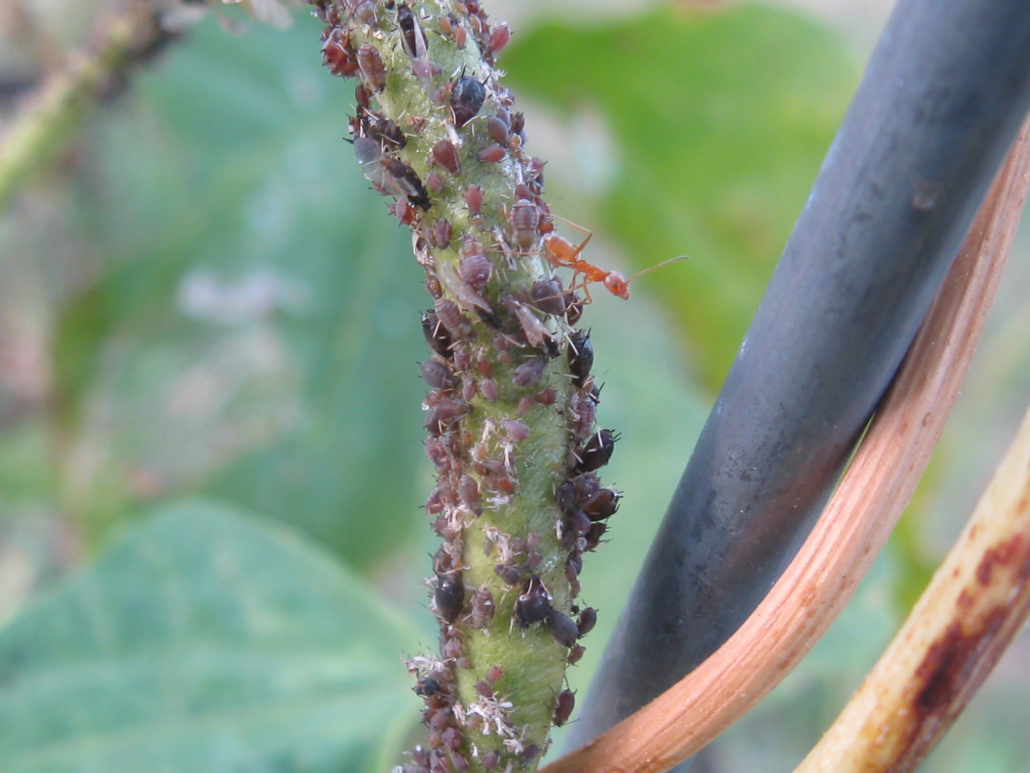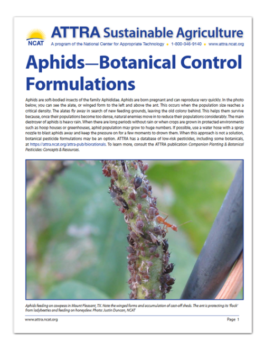Aphids — Botanical Control Formulations

By Justin Duncan, NCAT Agriculture Specialist
Introduction
Aphids are soft-bodied insects of the family Aphididae. Aphids are born pregnant and can reproduce very quickly. In this photo, you can see the alate, or winged form to the left and above the ant. This occurs when the population size reaches a critical density. The alates fly away in search of new feeding grounds, leaving the old colony behind. This helps them survive because, once their populations become too dense, natural enemies move in to reduce their populations considerably. The main destroyer of aphids is heavy rain. When there are long periods without rain or when crops are grown in protected environments such as hoop houses or greenhouses, aphid population may grow to huge numbers. If possible, use a water hose with a spray nozzle to blast aphids away and keep the pressure on for a few moments to drown them. When this approach is not a solution, botanical pesticide formulations may be an option. ATTRA has a database of low-risk pesticides, including some botanicals. To learn more, consult the ATTRA publication Companion Planting & Botanical Pesticides: Concepts & Resources.
Garlic
Garlic extract at 2% was found to kill about 75% of aphids in 24 hours on tea cuttings. The researchers made their solution by grinding 50 grams (g) of dried garlic, soaking it in water for 24 hours, straining through muslin cloth and then diluting 50 milliliters (ml) into 2.5 liters of water (Sohail et al., 2012). Another study looked at using garlic extracts on lettuce. This group’s research showed that garlic rapidly lost efficacy so reapplication was very important. Their solution was six large, crushed garlic cloves soaked in 30 ml of vegetable oil overnight and then strained and mixed into 2 liters of water (Rawleigh and Boyd, 2008). Both of these studies could have gotten better results if they had used higher concentrations of garlic extract. Of course, as with other botanical formulations, the efficacy of the final product will depend on many factors and you may have to experiment to find the best solution for the best results. It is worth noting that another researcher found that plots treated with garlic had higher ladybeetle populations (Wale, 2004).
Rosemary
In one study, rosemary essential oil (Rosmarinus officinalis) at 1,000 parts per million (ppm), or 17 drops in one liter of water, killed more than 57% of Myzus persica aphids after 48 hours (Hakimi et al., 2015). Researchers increased the concentrations of the oil up to 100,000 ppm, which increased the 24-hour kill percentage a bit but the 48-hour mortality remained about the same. This suggests that rosemary oil is volatile and will need to be re-applied quite frequently to be effective. Crude extracts of rosemary (Rosmarinus officinalis) were found to be ineffective in killing aphids (Nia et al., 2015) but may be useful in repelling them. This same study did see very effective results from using ether extracts from rosemary but not the crude or ethanol extracts.
Papaya Leaves
Papaya leaf extracts were found to significantly reduce cotton aphid (Aphis gossypii) populations on okra. One group of researchers used 100 g of blended fresh leaves in 1 liter of water, let the mixture sit overnight, and then sieved and mixed with another liter of water (Zobayer and Hasan, 2013). Another group used papaya (Carica papaya) leaf extract to fight the same aphids on both eggplants and okra and reduced aphids by half over the control group (Mochiah et al., 2011). Both groups added 10 ml fish emulsion and dish soap to the solution to make it adhere to plants more effectively.
Mint Family
Mint has been traditionally used as a companion plant to repel aphids. Recently, scientists in Egypt used extracts of mint (Mentha microphylla) to kill aphids. Their solution killed only a quarter to a third of the aphids and researchers found that highly refined fractions were more effective than the crude extracts (Sayeda et al., 2009). Another mint family member that affects aphids is catnip (Nepeta cataria) and its nepetalactones, which can mimic sex hormones in certain aphids. However, concentrated solutions of catnip extracts can also kill aphids. One researcher found that 14 ml/liter catnip essential oil in water killed 90% of cabbage aphids (Pavela, 2006). Be careful to not overdo it on this oil because 25 ml/liter in solution burned cabbage leaves in the study. Scientists have found that natural enemies of aphids pick up on nepetalactones and move in looking for prey (Birkett and Pickett, 2003).
References
Birkett, M.A. and J.A. Pickett. 2003. Aphid sex pheromones: from discovery to commercial production. Phytochemistry. March. 62(5). p. 651-6.
Hakimi, S., M. Ateyyat, and M. Bounechada. 2015. Insecticidal Activity of Five Essential Oils of Algerian Medicinal Plants on Peach Potato Aphid, Myzuspersicae (Homoptera: Aphididae). Advances in Environmental Biology. 9(2) January. p. 89-94.
Mochiah, M.B., B. Banful, K.N. Fening, B.W. Amoabeng, K. Offei Bonsu, S. Ekyem, H. Braimah, and M. Owusu-Akyaw. 2011. Botanicals for the management of insect pests in organic vegetable production. Journal of Entomology and Nematology. Vol. 3(6). August. p. 85-97.
Nia, B., N. Frah, and I. Azoui. 2015. Insecticidal activity of three plants extracts against Myzus persicae (Sulzer, 1776) and their phytochemical screening. Acta Agriculturae Slovenica. 105-2. September.
Pavela, R. 2006. Insecticidal Activity of Essential Oils Against Cabbage Aphid Brevicoryne Brassicae. Journal of Essential Oil Bearing Plants. Vol. 9, Issue 2. p. 99-106.
Rawleigh, S.O. and A.E. Boyd. 2008. Comparison of homemade and conventional sprays as aphid control on lettuce. Journal of the North Carolina Academy of Science. 124(2). p. 53-57.
Sayeda, F., Farghaly, H.M. Torkey, and H.M. Abou-Yousef. 2009. Natural Extracts and Their Chemical Constituents in Relation to Toxicity Against Whitefly (Bemisia tabaci) and Aphid (Aphis craccivora). Australian Journal of Basic and Applied Sciences. 3(4). p. 3217-3223.
Sohail, A., F.S. Hamid, A. Waheed, N. Ahmed, N. Aslam, Q. Zaman, F. Ahmed, and S. Islam. 2012.Efficacy of different botanical materials against aphid toxoptera aurantii on tea (Camellia sinensis L.) cuttings under high shade nursery. Journal of Materials and Environmental Science. 3 (6). p. 1065-1070.
Wale, M. 2004. Relative efficacy of some botanicals, detergent and kerosene in controlling the pea aphid Acyrthosiphon pisum (Harris) (Hemiptera: Aphididae) on grass pea Lathyrus sativus. International Journal of Tropical Insect Science. 05/2004; 24(02). p. 143- 149.
Zobayer, N. and R. Hasan. 2013. Effects of Manually Processed Bio-pesticides on Crop Production and Pest Managements in Okra (Abelmoschus Esculentus (L.) Moench). Journal of Natural Sciences Research. Vol.3, No. 8. p. 112-115.
Aphids — Botanical Control Formulations
By Justin Duncan, NCAT Agriculture Specialist
Published June 2016 ©NCAT
IP520
Slot 546
This publication is produced by the National Center for Appropriate Technology through the ATTRA Sustainable Agriculture program, under a cooperative agreement with USDA Rural Development. This publication was also made possible in part by funding from the National Institute of Food and Agriculture, U.S. Department of Agriculture, grant award number 2013-51106-20970. ATTRA.NCAT.ORG.


